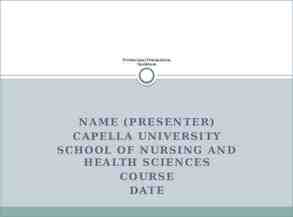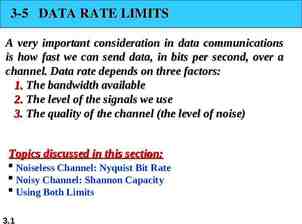Household Electronics Diodes & Rectification Component Identification
11 Slides554.00 KB

Household Electronics Diodes & Rectification Component Identification

UCSD: Physics 8; 2006 Diodes Diodes are essentially one-way current gates Symbolized by: Current vs. voltage graphs: I I I V plain resistor V diode I 0.6 V V idealized diode acts just like a wire (will support arbitrary current) provided that voltage is positive V WAY idealized diode the direction the arrow points in the diode symbol is the direction that current will flow no current flows Spring 2006 current flows 2

UCSD: Physics 8; 2006 Diode Makeup Diodes are made of semiconductors (usually silicon) Essentially a stack of p-doped and n-doped silicon to form a p-n junction – doping means deliberate impurities that contribute extra electrons (n-doped) or “holes” for electrons (p-doped) Transistors are n-p-n ir p-n-p arrangements of semiconductors (like oreo cookies) p-type Spring 2006 n-type 3

UCSD: Physics 8; 2006 LEDs: Light-Emitting Diodes Main difference is material is more exotic than silicon used in ordinary diodes/transistors – typically 2-volt drop instead of 0.6 V drop When electron flows through LED, loses energy by emitting a photon of light rather than vibrating lattice (heat) Anything with an LED cares about the battery orientation (it’s still a diode, after all) LED efficiency is 30% (compare to incandescent bulb at 10%) Spring 2006 4

UCSD: Physics 8; 2006 Getting DC back out of AC AC provides a means for us to distribute electrical power, but most devices actually want DC – bulbs, toasters, heaters, fans don’t care: plug straight in – sophisticated devices care because they have diodes and transistors that require a certain polarity rather than oscillating polarity derived from AC this is why battery orientation matters in most electronics Use diodes to “rectify” AC signal Simplest rectifier uses one diode: input voltage AC source Spring 2006 load diode only conducts when input voltage is positive voltage seen by load 5

UCSD: Physics 8; 2006 Doing Better: Full-wave Diode Bridge The diode in the rectifying circuit simply prevented the negative swing of voltage from conducting – but this wastes half the available cycle – also very irregular (bumpy): far from a “good” DC source By using four diodes, you can recover the negative swing: B & C conduct input voltage AC source A B A & D conduct C D load voltage seen by load Spring 2006 6

UCSD: Physics 8; 2006 Smoothing out the Bumps Still a bumpy ride, but we can smooth this out with a capacitor – capacitors have capacity for storing charge – acts like a reservoir to supply current during low spots – voltage regulator smoothes out remaining ripple AC source Spring 2006 A B C D capacitor load 7

UCSD: Physics 8; 2006 Voltage Regulator: Setting the Voltage Can trim down ripply voltage to precise, rock-steady value Now things get complicated! – We are now in the realm of integrated circuits (ICs) ICs are whole circuits in small packages ICs contain resistors, capacitors, diodes, transistors, etc. Spring 2006 8

UCSD: Physics 8; 2006 Transistors: a brief glimpse Transistors have made our modern world possible Sort-of like diodes end-to-end (npn and pnp junctions – but the sandwiched junction is very thin, and this is important A small current on the “base” can control a large current flowing from “collector” to “emitter” Can be used as an amplifier – make a weak signal stronger Or used as a switch – pedal-to-the-metal saturation regime Both are incredibly useful Spring 2006 9

UCSD: Physics 8; 2006 Operational Amplifiers (Op-amps) In essence, an op-amp is an idealized transistor/amplifier Has 20 transistors inside Idyllic properties: – linear amplification – temperature insensitivity – versatile So useful that electronics builders have trays full of them, and use them like “jelly-beans” Spring 2006 10

UCSD: Physics 8; 2006 Assignments/Announcements Q/O #2 due tomorrow by 6 PM Midterm 5/04 (next Thu.) 2PM WLH 2005 – – – – will post study guide on course website will have review session TBA Use Green Scantron: Form No.: X-101864 Bring #2 pencil, calculators okay Spring 2006 11






